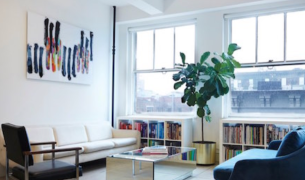This website uses cookies, by continuing to use this website you consent to the use of cookies.
Notes From the Field
I recently attended the AIGA New York talk, “Tall Tales from A Large Man,” featuring Aaron Draplin at The New School. It was an event I had been looking forward to all year, as Aaron Draplin’s attitude towards design and clients is something that really resonates with me personally and professionally.
I first heard about Aaron Draplin at my first agency job when I was 22 because Draplin was my mentor’s hero. My mentor, who was also a flannel-wearing, bearded, tall man, was an advocate of learning on the job, and he taught me real life skills at work that I didn’t learn in school, which is something Draplin prides himself on.
Although the talk was originally supposed to be “Tall Tales From A Large Man,” Draplin decided to change up the content and talk about what it was like creating his new book, “Pretty Much Everything,” which will be released on May 17th.
Hearing his design struggles and late nights at the office made the entire audience feel a level of connection to Draplin, as he does not claim to be above the things some designers think only happen early in your career. He accepted a job with Apple that coincided with the book, causing him to have to work 17 hours a day, seven day a week, from June to August last summer.
For someone who is always on brand with his design aesthetic, Draplin never goes off brand with his personal aesthetic. Aaron’s strength is his “every-man” appeal and dialect. His approachability and commitment to honesty is something to admire in a world that is driven by image and status. He never dresses up for an event or for other people; rather, he always wears what he is comfortable in and what represents him as a person. Meeting him was not like meeting other famous designers in that he had a very casual conversation with me about the merch he was selling and how “cash is king.” You would never know he was one of the most famous people in the design community due to his humble demeanor.
True to form, his talks are always delivered in a dialogue that is conversational, never preachy. The most successful designers and Creative Directors I have worked with use this conversational tone with clients and coworkers to keep the environment comfortable and open. Draplin’s greatest insights are from his learned experiences: he is not one to hide his failures. He stresses the importance of practicality in the field and scoffs at prodigies/elitist designers. My favorite thing he said was that he prefers designers who “get busy getting to work” as they are the true lovers of design because they work more than they talk.
Draplin never forgets where he came from, for he “is never above designing a back stage pass at a concert, because that’s where I started.” He is respectably humble and honest about his beginnings, starting designing at age 19 without any formal training, and going to college later in life on a scholarship. Draplin is now 42, and although appreciative for what he learned in school, he considers the lessons from the field much more useful in everyday life, not just as a designer but as a human being.
Because of his humble personality, his inspiration sources are often lesser-known designers and musicians who focused on the craft and not the fame. Two of his favorite, more well-known designers are David Carson and Chip Kidd: designers known for breaking the rules and focusing on what is essential in design. Similarly, my two favorite artists Geoffrey Johnson and Chuck Close, who are famous for their work but never embraced the celebrity lifestyle because they simply enjoyed what they did.
Draplin always wants to be as approachable as designs, so he carries this mentality to his products, which have become just as famous as him. His Field Notes notebooks have become somewhat of a staple in the design and travel community and are iconic to the Portland/Brooklyn millennial culture. Although three notebooks only cost $10, they are a staple in every creative’s bags and back pockets. I have used Field Notes for three years now, as they have gridded paper on the interior pages which makes them great for not only designing logos but for designing website wireframes as well. After I am done using the books, I save them all in anticipation of turning the used books into an art piece some day. There is a common theme across all of Draplin’s products: the focus on utilitarian goods and utilizing utilitarian typography on these goods. Draplin emphasizes the love for beautifully “under-designed” design in his products, drawing inspiration from stenciled typography on vans, vintage 1970’s band patches, old aluminum can labels, etc. His inspirations showcased the classic aesthetic of design when design was not yet a saturated market.
His book is a gorgeous compilation of his personal and professional brand, from process work as simple as napkin notes to full fledged logos for multi-million dollar companies. He includes personal anecdotes and homages to his parents in the book, as they were a huge part of his creative process and support system. His father, who recently passed, was a constant presence in the presentation, and is prominently tattooed on Draplin’s arm.
Draplin is designing an entire poster and brand series on “thick lines” and has owned the style of design using thick lines in the design field for the first time since the seventies. His work is heavily influenced by 70s design, retro desaturated palettes and geometric shapes. There is something to be said for a designer that focuses on perfecting one style, versus trying to perfect them all. Consequently, he is now the king of retro design in the branding world. He emphasizes the essential elements of the task at hand, never overcomplicating, and always providing clarity through his seamless executions. Aaron believes the most successful designs are the ones that are universally accessible to all audiences.
The most valuable lesson I took away from Draplin’s talk was his practical advice on being a human being in the design world. Although Draplin comes off as very relaxed and uses dialogue we use with just our friends, he acknowledges that even he has to be an “altar boy” when conversing with clients. Draplin starts every project at a very conservative conversational level to understand the personality of the client on the other end of the table/phone. You will never know what a client will react to, and it is always better to start off more reserved and ease your way into a more casual dialogue, to ensure at all points of the relationship that there is a level of mutual respect and professionalism.
With this in mind, he believes heavily in process. He showcased his Illustrator art boards in his book, showing hundreds of iterations of the same logo. Even after 23 years of designing, he does not get it right on the first try. Although his final presentation is always clean and extremely professional, his process is unkempt, drawing inspiration from a majority of non-digital items while embracing the old world approach to design as his standard. He encouraged all designers to have respect for the purposeful and functional, as those are the most successful designs and brands.
There is something to be said for a hero of design who is a humble, down-to-earth human being. Listening to Draplin’s talk helped change my design priorities and professional milestones. He has changed the face of what a “designer” can be. Draplin embraces being comfortable in his own skin, which is a struggle for a lot of designers. For this reason, he continues to be one of the most talented, strong and consistent brand designers in the game.



